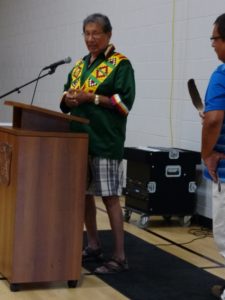Hereditary Chief honoured in Aamjiwnaang First Nation

By Colin Graf
AAMJIWNAANG FIRST NATION—Members of Aamjiwnaang First Nation have publicly honoured their Hereditary Chief for the first time.
Former Chief Phil Maness recently presented Hereditary Chief Wilson Plain, Sr. with a wampum-patterned ribbon vest designed by Plain’s nephew in honour of his status as eldest descendant of the community’s ancestor Animikence. He was one of 18 Chippewa Chiefs who signed the 1827 Huron Tract Treaty with the Canadian Government.
Maness made the presentation at the July swearing-in of the new Chief and Council following the Aamjiwnaang elections. “It’s time to acknowledge our past; our rich history,” said Maness in an interview. “It’s time to look at the electoral system that comes from the Indian Act and recognize our Hereditary Chiefs as well,” he said.
Since First Nations are in the process of developing their own constitutions, this is the perfect time to remember the Hereditary Chiefs, said Maness. He wants to identify the importance of ancestral leaders in the Aamjiwnaang constitution. With reconciliation being the important theme of the current time, Maness says recognizing the Hereditary Chief can help promote reconciliation within First Nations’ communities.
The presentation of the vest was the first time Plain remembers his family being acknowledged as Hereditary Chiefs, and he felt honoured by the recognition. He sees a place for himself and other traditional Chiefs to be like the House of Lords or Peers in England—giving advice and wise suggestions to the elected leadership. Every First Nation person has Elders to whom he or she turns to when seeking advice, but the Hereditary Chief should be someone any community member can turn to, he said.
First Nations have sometimes been reluctant to recognize Hereditary Chiefs because of the electoral system that’s been in place under the Indian Act since the 1800’s. Councils have been “nervous to recognize other leadership that may have influence on decision-making,” he claims.
Does that mean recognizing Hereditary Chiefs could lead to more conflict rather than reconciliation? Not in his case, Plain asserts. “I know my status. I have a responsible position that can be used by elected councils and others if they want to,” he explains modestly.
Maness also presented out-going Aamjiwnaang Chief Chris Plain with an Eagle Feather in recognition of his service to the band over more than a decade in office, such as expansion of the local community centre which features a fitness centre, arts and crafts rooms, and a senior’s lounge. A skatepark and splashpad have also been added.
The Treaty signed by Plain’s ancestor Animikence surrendered over 2 million acres of what is known today as south-western Ontario to the Crown in 1827. The 18 Chiefs preserved four tracts of land for their 440 members. The four lands were in Sarnia, south along the St. Clair River; at Kettle Point along Lake Huron; at the mouth of the Ausable River, near Pinery Provincial Park; and the present day town of Grand Bend.
A monetary grant was to be paid yearly, equivalent to about $10/person/year (information gathered by the Ipperwash Inquiry).


